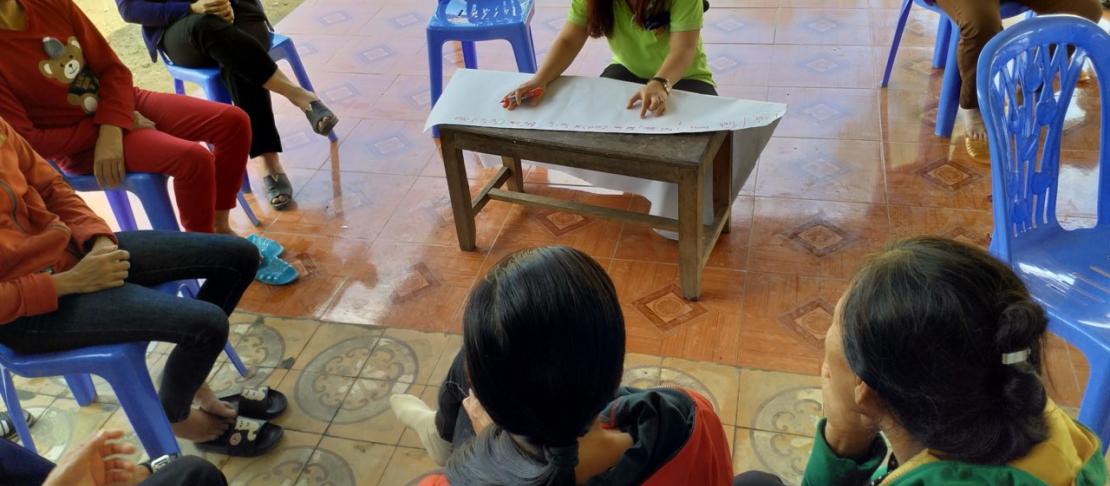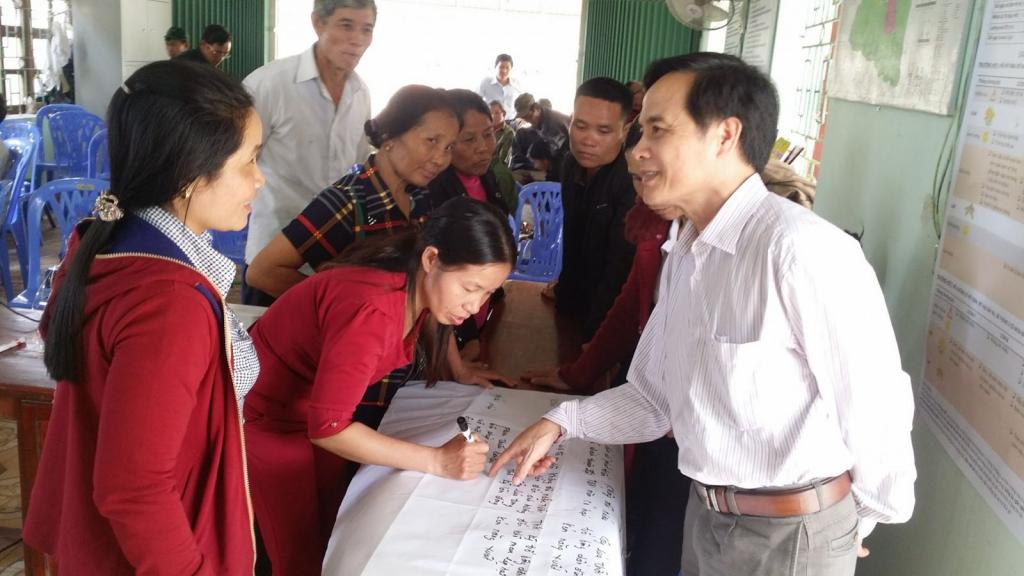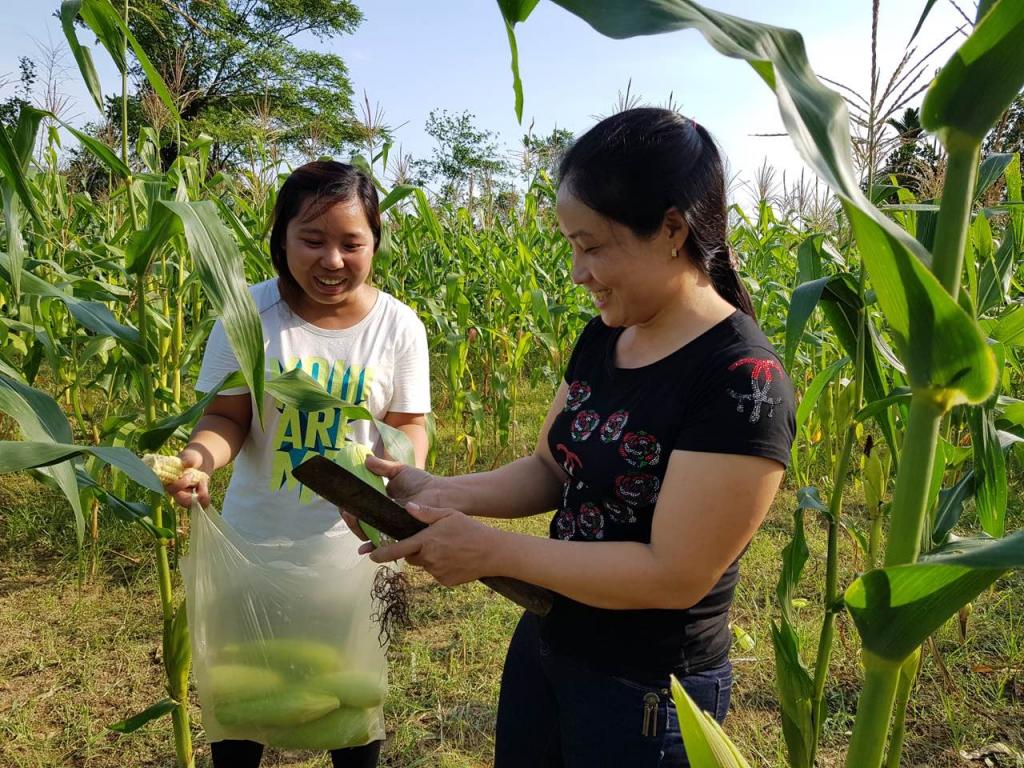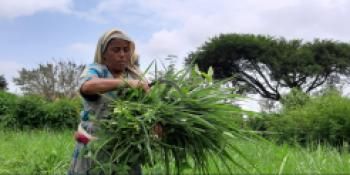Weather forecasts for all: Improving access to weather information for women and ethnic minorities

A project in My Loi climate-smart village helps women and ethnic minorities access weather data and use it to inform agriculture decisions.
As climate change reshapes weather patterns, forecasting helps smallholder farmers protect themselves and their farms against erratic weather. Smallholder farmers, however, especially women and ethnic minorities, are often unable to fully access and make use of meteorological data. An ongoing project in Vietnam’s My Loi Climate-Smart Village (CSV) helps to give marginalized groups access to weather information and use it to inform decision making.
One of the staff members working on this project is Tam Thi Le, a research assistant with the World Agroforestry Centre (ICRAF). CCAFS’ Gender and Social Inclusion (GSI) Unit reached out to learn more about her work and the project’s outcomes.
Why are women and ethnic minorities less likely to be involved in weather forecasting and monitoring?
Generally, people living in remote areas have limited access to climate information, including weather and seasonal forecasts and extreme weather warnings.
Women and ethnic minorities have even less access to information. Women’s family and household tasks, from childcare to agricultural production, leave them with less time to read and listen to the news. Additionally, information provided by service centers may not meet their needs as it can be too technical and in an inappropriate format.
Women and ethnic minorities also have limited mobility due to time restrictions and ability to drive motorbikes, reducing their chances of obtaining new information. Finally, education is a barrier for ethnic minorities, as many do not read and write Vietnamese.

Participatory scenario planning. Photo: Duong Minh Tuan (ICRAF)
What specific activities did women participate in as part of this project?
The Agro-Climate Information Services for Women and Ethnic Minority Farmers (ACIS) project helps farmers access climate information and agro-advisories. ACIS is based on a participatory action research approach, bringing together multiple stakeholders, including weather forecasters, extension and agriculture staff, local authorities, farmer unions, and farmers. The project closes the loop between producers, translators, and users of climate information. In participatory scenario planning meetings, farmers discuss and prepare plans and reflect on their previous actions, which builds trust in the climate product.
Women are encouraged to share their knowledge, needs, and ask and answer questions. They are often secretaries in farmer groups, in charge of group budget expenses and finacial recordings, in addition to designing, formatting, and evaluating information to include in agro-advisory bulletins. Gender is also mainstreamed throughout all project activities and trainings.
How does your role as a woman and a leader affect women and men in the village?
Trust is one of the most important things for researchers to consider as it improves our relationship/social capital and helps both men and women farmers believe in what we are doing. Together, we have a common understanding of benefits as well as limitations and challenges. As a female researcher/facilitator, I can openly and easily talk to women. I sit in their home garden and explore what their livelihood challenges, needs, and wishes are. I also facilitate women-based group discussions and encourage mixed gender groups.
In CSV projects, we provide women and men the opportunity to join a Participatory Scenario Planning Platform to express their ideas, needs, and challenges with a wider audience of stakeholders. In this way, farmers, practitioners, and scientists combine their knowledge to co-produce agro-advisories.

Informal discussion with a female farmer. Photo: Duong Minh Tuan (ICRAF)
What changes have you seen in the village since you began working there?
The participatory approach encourages participants to ask questions, facilitate discussions, and share their experiences with peer farmers and local leaders. In the beginning, usually one household member participated in the project. Now, more couples are participating together. Farmers in the village know more about climate change and its impacts and they value the agro-bulletin because it is participatorily made and, therefore, easy to understand and use.
Women, especially, are more confident in raising their voices, presenting, facilitating group discussions, and asking government staff to support them. Some women actively share project lessons with other farmer groups. After participating, women use inputs more efficiently, choose appropriate crop varieties, avoid crop loss, and adjust their farming schedule to avoid flood risks.
What types of local knowledge do women possess and how does this knowledge contribute to the overall goals of this project?
Knowledge comes from generational observations and experiences. For example, women pay attention to how ants and bees move and the flying height of dragonflies to forecast the weather. Women also have knowlegde on managing annual crops, local vegetables, and tubers. They know which crops combine best with each other to generate higher incomes and diversify production risks. They also have local ways of controlling pests and diseases using lime and soot. These existing climate-smart agriculture practices can be maintained, improved, and shared.
How can women be encouraged to hold leadership/staff positions?
We need to help women trust themselves and want to be leaders by providing opportunities for actions and activities they are already good at or interested in. Leadership training and showcasing examples of women leaders is also important. Finally, giving women the chance to be leaders/facilitators of small groups motivates them to strive for higher positions in the community.
Men also need to understand and appreciate women’s contributions. Even within households, information sharing and joint decision making can reduce gaps between the genders. Once women are supported by their partners to join meetings, trainings, events, and other social activities, they have the chance to learn, interact, and develop.
Read more:
- Blog: Farmers, agricultural advisors need more detailed, area-specific climate information for climate-smart farming
- Blog: Collaboration brings focused agricultural advice to farmers in Ha Tinh, Vietnam
- News Update: Expert forecasts and local knowledge as sources of agro-climate information
Kathlee Freeman is a Communications Consultant for CCAFS Gender and Social Inclusion (GSI).



